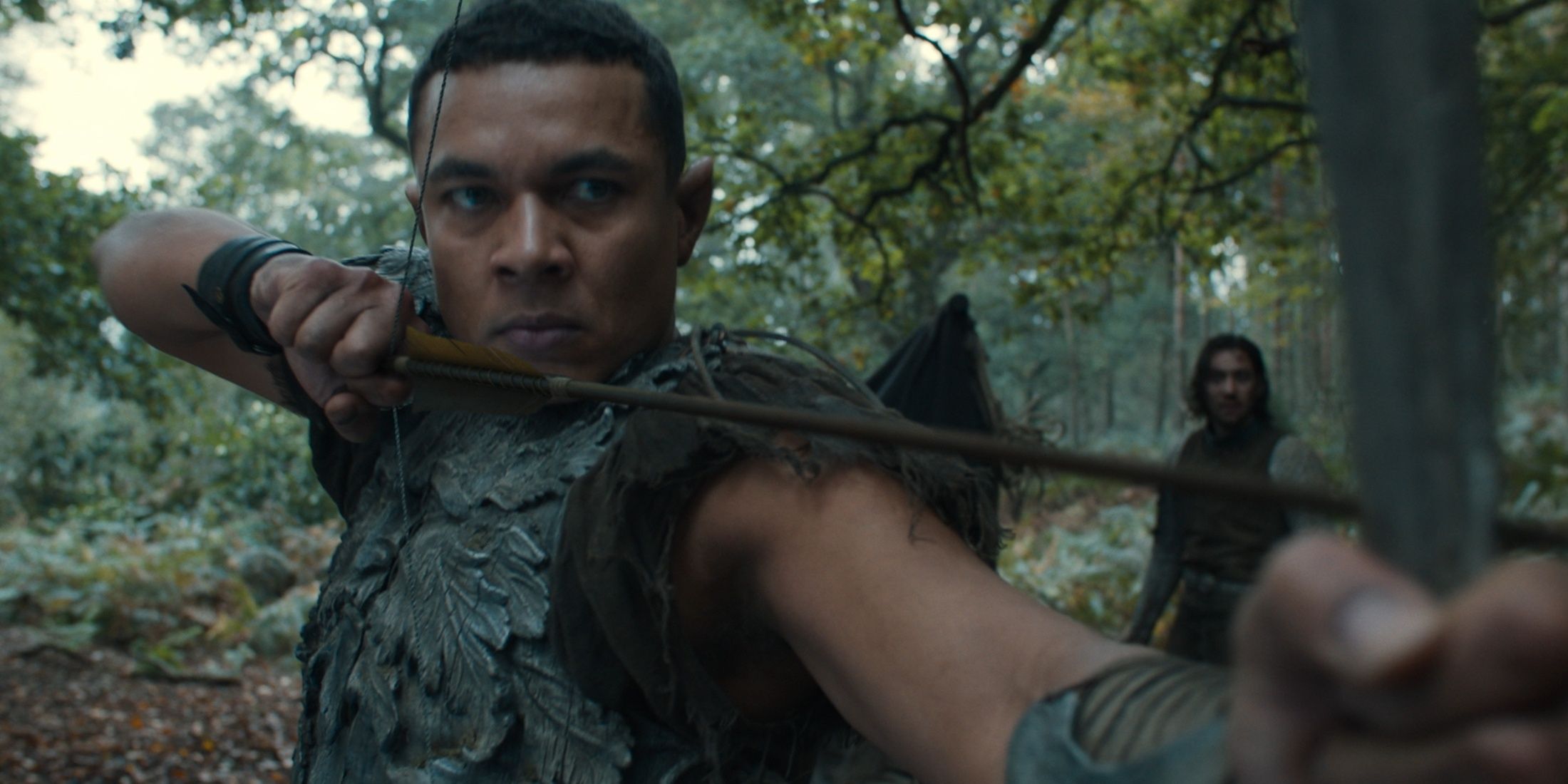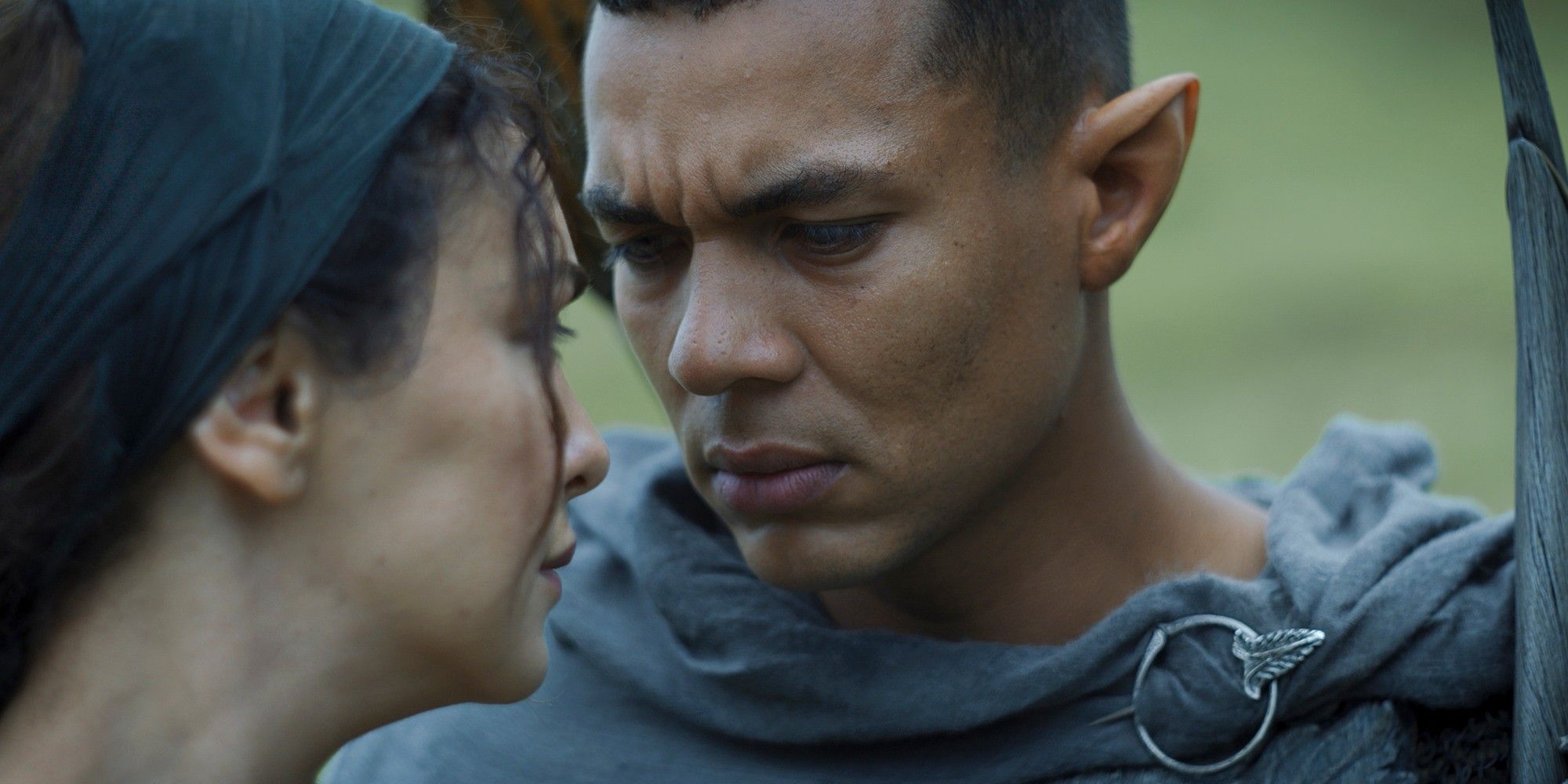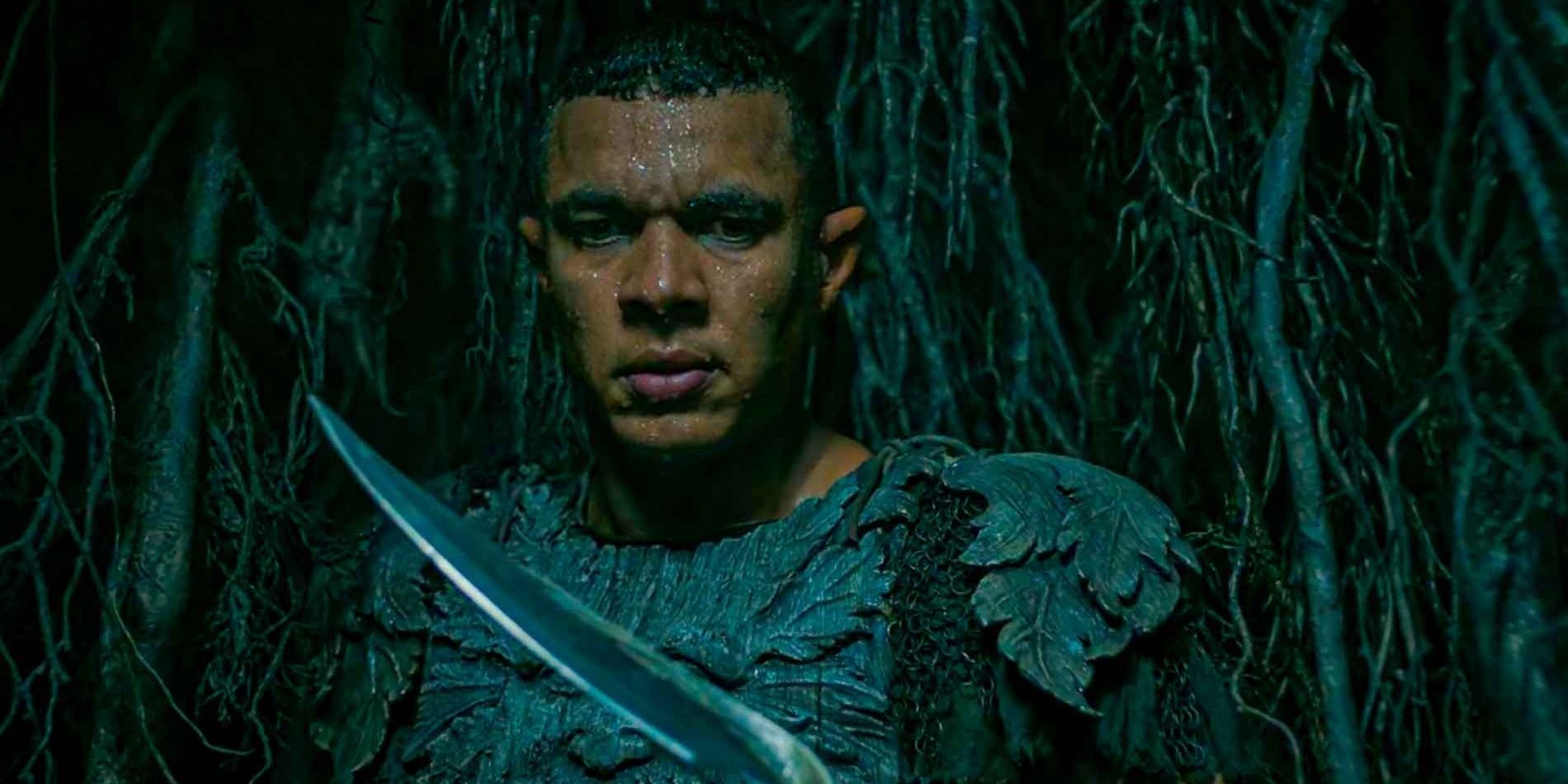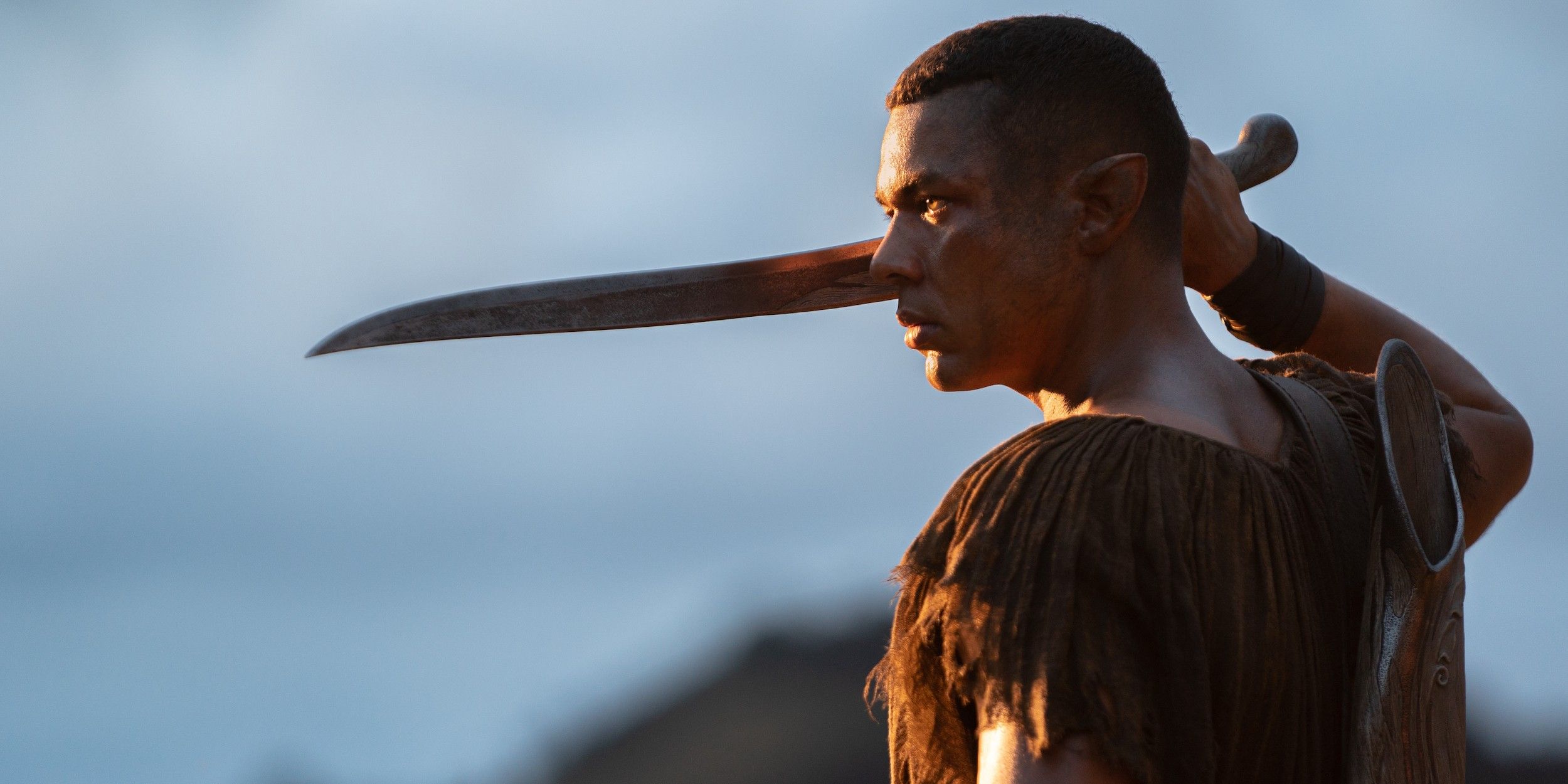
Arondir first appeared in The Rings of Power‘s premiere, “A Shadow of the Past,” performing his biweekly check-in to a village called Tirharad. He entered a tavern to ask the barkeep, Waldreg if anything unusual had happened lately. From his first scene, it was clear that the Men of the Southlands resented the Elves who watched over them. One of the tavern’s patrons angrily told Arondir — or “knife-ears,” as he mockingly called him — that the alliance with Morgoth happened over a thousand years ago and that the Elves needed to let go of the past. Waldreg was friendlier, but he still withheld information from Arondir, clearly wanting the inspection to end as quickly as possible. However, there was one villager with whom Arondir had a better relationship.
Updated on September 18th, 2024 by Robert Vaux: With the arrival of Season 2 of The Rings of Power, attention has returned both to Arondir, and the creative challenges he represents as Tolkien’s adapters seek to expand his world without violating its spirit. The article has been expanded to contextualize the character within the greater canvas of Tolkien’s work. The formatting has been updated to meet CBR’s current guidelines.
Arondir Evokes the Era in Which He Lives

Arondir’s birthplace of Beleriand was destroyed during the War of Wrath near the end of the First Age.
Tolkien never used the term “knife-ears,” but it did appear in other fantasy media, such as the Dragon Age series of video games.
Arondir said that the inhabitants of Hordern had been especially loyal to Morgoth, which offended Bronwyn.
Arondir was created specifically for The Rings of Power, rather than coming from Tolkien’s works. Fans continue to debate the use of such characters in Middle-earth adaptations, with some maintaining that it violates the original text and others arguing that it’s a necessary part of developing the universe for mediums like television. Regardless, it’s intended to reveal the backstory leading up to the events of The Lord of the Rings, drawing heavily from The Silmarillion and the author’s other collected notes. “Notes” is often an apt description, with Tolkien often simply recounting events in order to properly establish the history of Middle-earth, rather than trying to craft it all into a cohesive narrative.
Accordingly, The Rings of Power needs to make a number of changes in order for those events to work as storytelling. Middle-earth’s history undergoes a great deal of compression, for starters, with characters and situations formerly spaced out over centuries now packaged within a few brief months. In other areas, it radically expands on details that Tolkien kept brief, or never described at all. That includes the creation of Mordor, Sauron’s seat of power and the eventual destination for Frodo’s quest to destroy the One Ring. The original books keep its description minimal, though Tolkien’s The History of Middle-earth mentions that Mount Doom was created by Sauron’s predecessor Morgoth during Middle-earth’s First Age. Sauron settles there in the Second Age to build his empire and forge the One Ring. The human kingdom of Numenor captures him thousands of years later, imprisoning him in Numenor where he winnows into a position of influence and orchestrates the island nation’s destruction. He then returns to Mordor, where he remains until the Last Alliance defeats him at the end of the Second Age. (The battle is covered in the opening montage of Peter Jackson’s adaptation of The Fellowship of the Ring.)
The Rings of Power must condense and streamline all of that to fit into a coherent plot, rather than just serving as backstory. Season 1 details how Sauron himself creates Mordor through deceit and treachery, as part of his larger plan to trick the Elves into forging Rings of Power. He does so by exploiting divisions between Men and Elves, with humanity growing increasingly resentful of their former allies’ imperious ways, and the Elves’ quietly yearning to leave Middle-earth and return to the Undying Lands to the west. Arondir was created in part to demonstrate those changes, as well as revealing aspects of day-to-day life in the Second Age of Middle-earth. He’s essentially a soldier stationed in “the Southlands,” a human-occupied area that will eventually become Mordor. Its inhabitants supported Morgoth in his war against the Elves, and the Elves continue to monitor them to ensure that they don’t revert to their former ways. Arondir is thus essentially a member of an occupying force, and his presence both demonstrates the political logistics of Middle-earth at this time, and provides an audience surrogate to witness Sauron’s slow creation of Mordor.
Arondir Had a Forbidden Love

Though neither had spoken their feelings aloud, there was clear romantic tension between Arondir and the local village’s healer, Bronwyn. She gifted him seeds from the rare alfirin flower, which he said he had not seen since he was a child. This was the same type of flower that grew on the graves of Rohan’s royals in The Lord of the Rings, although the Rohirrim instead called it simbelmynë. Later in The Rings of Power, Arondir would plant these seeds as part of a pre-battle ritual. Arondir’s fellow Elf, Medhor, warned him against falling in love with Bronwyn, as pairings between Elves and Men always ended in tragedy. He alluded to two such pairings from Tolkien’s writing: those of Beren and Lúthien and Tuor and Idril. Unfortunately for Arondir’s blossoming romance, High King Gil-galad declared that the war was over and that Elves no longer needed to watch over the Southlands.
Arondir made one last visit to Bronwyn to tell her how he truly felt, but before he got the chance, a man with a sick cow came asking for her help. The cow had eaten poisoned grass near Hordern, the village where Bronwyn was born. She and Arondir went there to investigate, and they found only fiery ruins. While Bronwyn left to warn Tirharad, Arondir explored the tunnels under the village, where Orcs knocked him out and captured him. He awoke, bound in chains, alongside many other Elves. The Orcs could not stand sunlight, so they were forcing their prisoners to dig trenches they could use to traverse in darkness. Arondir had to cut down an ancient tree in their path, which devastated him, as Elves usually treated nature with the utmost respect. The Rings of Power established this back in the first episode, as Arondir was upset by the notion that Bronwyn crushed flower petals to make her medicine. Near the end of the episode, the Elves try to escape. They nearly succeeded, killing several Orcs and even a ravenous Warg in the process, but Orc archers foiled their escape attempt.
Arondir Was a Master Combatant










The Orcs recaptured Arondir and brought him to their leader, the corrupted Elf Adar — another character invented for The Rings of Power. He freed Arondir on the condition that he deliver a message to the people of Tirharad: if they did not join him, he would kill them all. On the way there, Arondir rescued Bronwyn’s son Theo from some Orcs, forming the start of a bond with the boy. He relayed Adar’s message to the people of Tirharad, who had taken refuge in the former Elven watchtower of Ostirith after an Orc attacked Bronwyn’s house. Waldreg, who secretly worshipped Sauron, said that they did not stand a chance against Adar and urged the other villagers to accept the offer. About half of the villagers agreed with him, and they left to pledge their loyalty to Adar. Arondir stayed with the others to help them survive the coming attack. They rigged Ostirith to collapse as a trap for Adar’s forces then returned to the village and fortified it. Their last and strongest line of defense was the tavern, which contained all those who could not fight.
The villagers of Tirharad were mostly inexperienced in combat, and Adar’s forces far outnumbered them, so they relied on stealth and strategy as much as possible. They set up barricades near the entrance of the village and lit them with flaming wagons once the Orcs were inside. This did minimal damage, but it slowed them down long enough for archers stationed on the rooftops to begin picking them off. Arondir showcased the speed and accuracy for which Elves were famous in The Lord of the Rings. Once the Orcs reached the tavern and tried to beat the door down with a battering ram, many villagers ran out from their hiding places and ambushed them. Arondir nearly died at the hands of a particularly large Orc brute, but Bronwyn saved him. Against all odds, the villagers of Tirharad won the battle. However, Arondir noticed that most of the slain enemies were not Orcs; they were the villagers who had joined Adar. This was a doubly harrowing revelation, as it not only meant that they had killed their former neighbors but also that Adar’s Orc army was largely intact.
Arondir Saved Bronwyn’s Life
Though Arondir did not appear in Tolkien’s works, The Silmarillion briefly mentioned a similarly named Elf: Aerandir.
Arondir said that he had been stationed in the Southlands for 79 years.
Ostirith’s name roughly translated to “fortress of guard” in the Elvish language of Sindarin.
They did not have long to process this, as the second wave of Adar’s forces then arrived. Orc archers began killing the villagers and shot Bronwyn through the back. The survivors retreated to the tavern, where Arondir healed Bronwyn with her son’s help, but the Orcs soon broke in. Adar threatened Bronwyn, which caused Theo to give him what he was after the magic Orc Sigil Hilt. Regardless, Adar ordered his Orcs to slaughter the villagers. Just when all seemed lost, Galadriel and the Númenóreans arrived. They wiped out the Orcs and captured Adar for interrogation. When Theo asks Arondir who Galadriel is in the episode “Udûn,” he says, “Commander of the Northern Armies” in a way that makes it clear he admired her.
Despite winning the battle, Adar had accomplished his mission; he secretly gave the Orc Sigil Hilt to Waldreg, who used it to trigger the eruption of Mount Doom. Fire and ash rained down on the Southlands, transforming it into Mordor. This destroyed Tirharad, and it killed or wounded several of the villagers and Númenóreans. Arondir’s last appearance was in the season’s penultimate episode, “The Eye.” Despite all they had lost, he was comforted by the fact that Bronwyn and Theo survived the ordeal. Though Prime Video has released few details about The Rings of Power‘s second season, Córdova is set to return as Arondir. He will likely accompany Bronwyn as she leads the remnants of her people to Pelargir, an area that will eventually become part of Gondor. Though Arondir did not originate in The Lord of the Rings, his bravery, sensitivity, and ingenuity made him one of the most compelling characters in The Rings of Power‘s first season.



